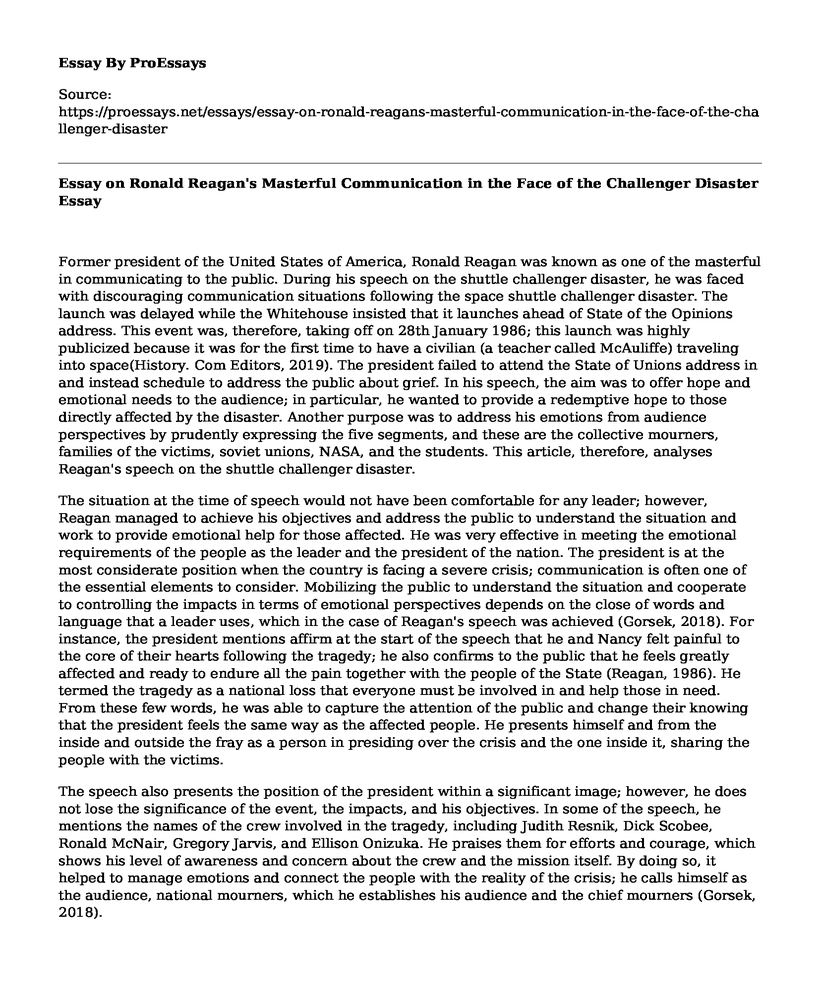Former president of the United States of America, Ronald Reagan was known as one of the masterful in communicating to the public. During his speech on the shuttle challenger disaster, he was faced with discouraging communication situations following the space shuttle challenger disaster. The launch was delayed while the Whitehouse insisted that it launches ahead of State of the Opinions address. This event was, therefore, taking off on 28th January 1986; this launch was highly publicized because it was for the first time to have a civilian (a teacher called McAuliffe) traveling into space(History. Com Editors, 2019). The president failed to attend the State of Unions address in and instead schedule to address the public about grief. In his speech, the aim was to offer hope and emotional needs to the audience; in particular, he wanted to provide a redemptive hope to those directly affected by the disaster. Another purpose was to address his emotions from audience perspectives by prudently expressing the five segments, and these are the collective mourners, families of the victims, soviet unions, NASA, and the students. This article, therefore, analyses Reagan's speech on the shuttle challenger disaster.
The situation at the time of speech would not have been comfortable for any leader; however, Reagan managed to achieve his objectives and address the public to understand the situation and work to provide emotional help for those affected. He was very effective in meeting the emotional requirements of the people as the leader and the president of the nation. The president is at the most considerate position when the country is facing a severe crisis; communication is often one of the essential elements to consider. Mobilizing the public to understand the situation and cooperate to controlling the impacts in terms of emotional perspectives depends on the close of words and language that a leader uses, which in the case of Reagan's speech was achieved (Gorsek, 2018). For instance, the president mentions affirm at the start of the speech that he and Nancy felt painful to the core of their hearts following the tragedy; he also confirms to the public that he feels greatly affected and ready to endure all the pain together with the people of the State (Reagan, 1986). He termed the tragedy as a national loss that everyone must be involved in and help those in need. From these few words, he was able to capture the attention of the public and change their knowing that the president feels the same way as the affected people. He presents himself and from the inside and outside the fray as a person in presiding over the crisis and the one inside it, sharing the people with the victims.
The speech also presents the position of the president within a significant image; however, he does not lose the significance of the event, the impacts, and his objectives. In some of the speech, he mentions the names of the crew involved in the tragedy, including Judith Resnik, Dick Scobee, Ronald McNair, Gregory Jarvis, and Ellison Onizuka. He praises them for efforts and courage, which shows his level of awareness and concern about the crew and the mission itself. By doing so, it helped to manage emotions and connect the people with the reality of the crisis; he calls himself as the audience, national mourners, which he establishes his audience and the chief mourners (Gorsek, 2018).
Reagan manages to narrow to use excellent communication skills to narrow the focus on the most affected audiences, including family members of the fallen crews. He acknowledges the inappropriateness of mentioning how the mourners should feel and instead presides over the praise that they could take hold of by using the words such as special grace, special spirit, brave, and daring.
Conclusion
The speech presents Raegan's ability to mobilize the public, use of good communication to address the public during a disaster. He credibly manages to speak of the disaster from different audiences' perspectives addressing emotional feelings, identifying the fallen, and praising their efforts. The speech, therefore, is one of the efforts in his government that made him a great president and best communicator. The speech lasted for a short time, but he managed to address his objectives and effectively engaged people to connect with the tragedy.
References
Gorsek, S. (2018). Not the Final Frontier: A Rhetorical Analysis of Ronald Reagan's Challenger Eulogy. Articulate, 23(1), 2. Retrieved from: https://digitalcommons.denison.edu/cgi/viewcontent.cgi?article=1123&context=articulate
History. Com Editors. (2019). Challenger Explosion. Retrieved from: https://www.history.com/topics/1980s/challenger-disaster
Reagan, R.W. (1986). Explosion of the Space Shuttle Challenger Address to the Nation. Retrieved from: https://history.nasa.gov/reagan12886.html
Cite this page
Essay on Ronald Reagan's Masterful Communication in the Face of the Challenger Disaster. (2023, Apr 24). Retrieved from https://proessays.net/essays/essay-on-ronald-reagans-masterful-communication-in-the-face-of-the-challenger-disaster
If you are the original author of this essay and no longer wish to have it published on the ProEssays website, please click below to request its removal:
- The Significance of the Completion of the Baptistery Doors of the Cathedral of Florence
- Essay Sample on Women in Ministry: Examining the Barriers to Ordination
- Essay Sample on Suzhou Pingtan
- Poetry and Graphic Design Essay
- Human Communication: Verbal & Non-Verbal Expressions - Essay Sample
- The Pyramids - Free Essay Sample
- Exploring Social Issues: An Analysis of the Documentary 'The Hard Stop'







